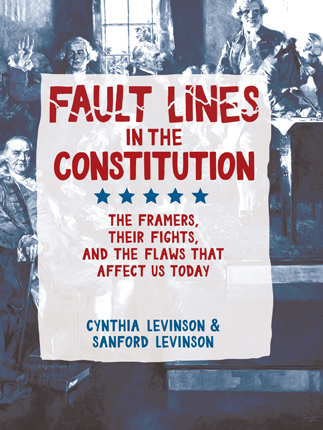| Fault lines in the constitution : the framers, their fights, and the flaws that affect us today Author: Levinson, Cynthia | ||
| Price: $6.50 | ||
Summary:
Examines the Constitutional origins of modern-day political problems and outlines solutions for these issues.
| Added Entry - Personal Name: | Levinson, Sanford |
| Accelerated Reader Information: Interest Level: MG+ Reading Level: 8.80 Points: 9.0 Quiz: 190605 | Reading Counts Information: Interest Level: 6-8 Reading Level: 10.50 Points: 13.0 Quiz: 71810 | |
Reviews:
School Library Journal (+) (00/08/17)
Full Text Reviews:
School Library Journal - 08/01/2017 Gr 6–8—Gerrymandering. Filibusters. The electoral college. The authors tackle these and other constitutional issues in this insightful work. The book functions differently than a straightforward explanatory text on the U.S. Constitution. Rather, the authors examine the fissures and issues that arise when it comes to the actual application of the Constitution: Why does a small state have the same power in the Senate as a state with exponentially higher population? How can certain stipulations in the Constitution deter otherwise popular legislation? The text discusses current conflicts, such as the irony of "Taxation Without Representation" in regard to Washington, DC, and Senate filibusters that kill potentially popular legislation before it can even be voted on. Historical situations are also examined, such as the Sedition Act of 1918 that barred anti-war speech during World War One. The book provides readers with a broad context of constitutional law; the text explores how various parts of the U.S. Constitution compare with individual state constitutions and other nations' constitutions. The authors not only raise timely issues, but provide readers with options of how a seemingly obsolete stipulation can be amended. Many examples of amended laws, e.g., the repeal of Prohibition, illustrate the evolving nature of the law. At times, the authors seem to express their support of a more direct democracy. They also provide a "report card" on the Constitution's ability to handle its objectives, such as "Form a More Perfect Union" and "Promote the General Welfare." Pons's helpful illustrations resemble infographics, pulling out startling facts from the text and repackaging them visually. VERDICT Much food for thought on the application and relevance of many of the Constitution's stipulations. Essential for class discussions, debate teams, and reports.—Jeffrey Meyer, Mount Pleasant Public Library, IA - Copyright 2017 Publishers Weekly, Library Journal and/or School Library Journal used with permission.
Booklist - 09/01/2017 *Starred Review* Lately there’s been dismay that civics, government, and history have taken a backseat in classrooms. This smartly conceived book goes a long way toward reintroducing students to those subjects. After an informative introduction that dissects the Preamble and covers the leap from the Articles of Confederation to the Constitution, the Levinsons link both history and current events as they offer an illustrative group of examples that show where the Constitution got it right—and wrong. The nine chapters cover a wide range of topics, including bicameralism, presidential vetoes, gerrymandering, term limits, and voting rights. Each chapter begins with a controversial news event or court case. These are well-chosen: whether John McCain, born in the Canal Zone, was eligible to run for president; how a 101-year-old Texas woman was deprived of her vote because she lacked an approved ID; FDR’s right to run for a third term. Then the chapters pivot (“Meanwhile, Back in 1787”) and describe the framers’ thinking on the topic. Other repeated sections examine the relevant topic in-depth; describe alternate methods, used by other states or countries, to deal with the issue; and explain how that issue played out and the effects it may continue to have today. Although the font, charts, and well-written text make this appealing, it’s not always an easy read. It is, however, an important one. - Copyright 2017 Booklist.




